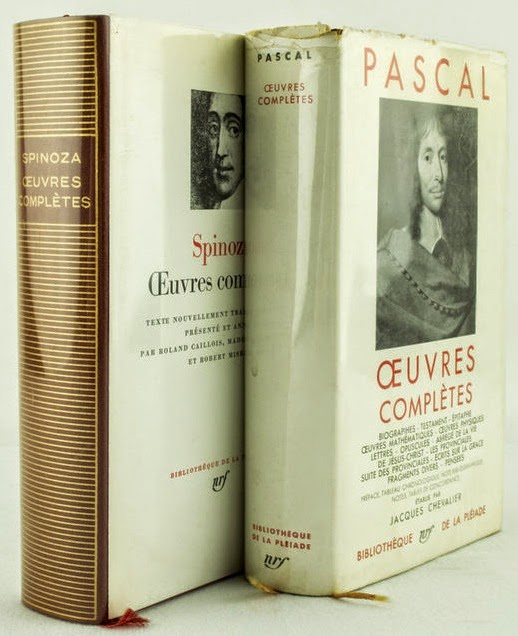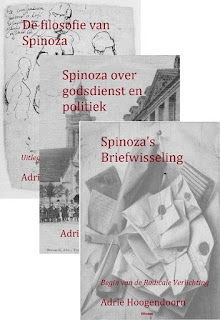Pascal (1623 - 1662) en Spinoza (1632 - 1677)
Behalve dat ze beiden in de 17e eeuw leefden en dachten als filosofen, en allebei jong stierven - Blaise op 38-, Benedictus op 44-jarige leeftijd - zijn er toch nauwelijks redenen ze in één blog te noemen. Enige verschillen tussen hen heb ik in eerdere blogs benoemd. Toch vind ik het wel aardig dat hun verzamelde werken in één veilingkavel werden samengebracht [cf.], deze Oeuvres complètes uit de Bibliothèque de la Pléiade met leren band en stofomslag, die van Pascal uit 1957 en die van Spinoza uit 1978.

Daar in de volgende tekst Pascal en Spinoza min of meer toevallig vlak achter elkaar voorkomen, neem ik de openingsalinea’s van Joseph Bottum’s artikel “Words of Nectar and Cyanide” uit mei 2009 hier over [Cf. - books.google Ik kwam niet bij deze tekst terwijl ik op zoek was naar Spinoza of/en Pascal, maar naar iemand anders: Éluard. Maar als ik dit dan zie, laat ik de kans niet lopen]:
You can trace, through the history of philosophy, a line of aphorism —that odd, somewhat disreputable method of doing philosophy as a kind of bastard poetry. Maybe even as a kind of magic: truth as something to be summoned by careful incantation and the weird precision of a witch's spell.
It starts with Heraclitus, of course, and the deliberately obscure metaphysical assertions that either began as aphorisms or, left as fragments from his lost essays, ended up that way: Time is a child moving counters in a game, and The way up and the way down are one, and We both step and do not step in the same rivers. Epicurus, perhaps, did philosophy in this epigrammatical way. Diogenes and Marcus Aurelius certainly did. And then there are all the half-lost Greeks: Sophists, Epicureans, Atomists, Cynics, Skeptics, and Stoics, together with occasional Presocratics and random Neoplatonists and stray Peripatetics—the long parade of ancients whose words survive only in the scraps and slivers that make them sound like maddened masters of philosophical concision.
Revived in the Renaissance, this method of doing philosophy by dictum and adage would flower particularly among the French: the civilized Montaigne, the polished La Rochefoucauld, the God-haunted Pascal. Spinoza did a little of it, from time to time. Nietzsche's aphorisms would raise the method to a high art form in the nineteenth century, and Wittgenstein's Zettel would return it in the twentieth century to the pure philosophical density with which it began in Heraclitus.
Interestingly, you can also trace a line of pessimism through the history of philosophy, and it would weave in and out to touch this line of aphorists at a surprising number of points. Perhaps none of them quite reach the grim perfection of Samuel Beckett's image of existence as the brief fall from a bloody womb to a splattered death—of human life as a woman giving birth while she squats astride an open grave. But it's there, often enough, in the senseless physical universe perceived by the ancient Cynics and Skeptics and even some of the Stoics. It's there among the Epicureans, too, for all that they demand the pursuit of pleasure: "From the heart of the fountain of delight," as Lucretius points out, "there rises a jet of bitterness that tortures us among the flowers."
Hierna gaat hij de aforistische lijn en de pessimistische lijn samenbrengen in Emil Mihai Cioran. Het gaat verder vooral over de levensvisie van Cioran.
* * *
Joseph Bottum's “Words of Nectar and Cyanide” reports on famous sayings of philosophers about life itself, and not just about the sayings of other philosophers. [aldus Richard J. Rolwing, Was Frankenstein Really Uncle Sam? Xlibris Corporation, 2010]
http://books.google.nl/books?id=F7SaAgAAQBAJ

